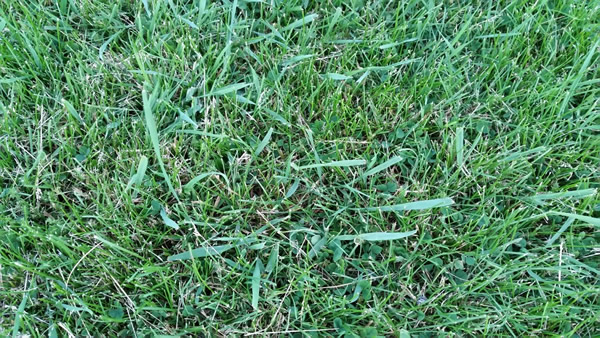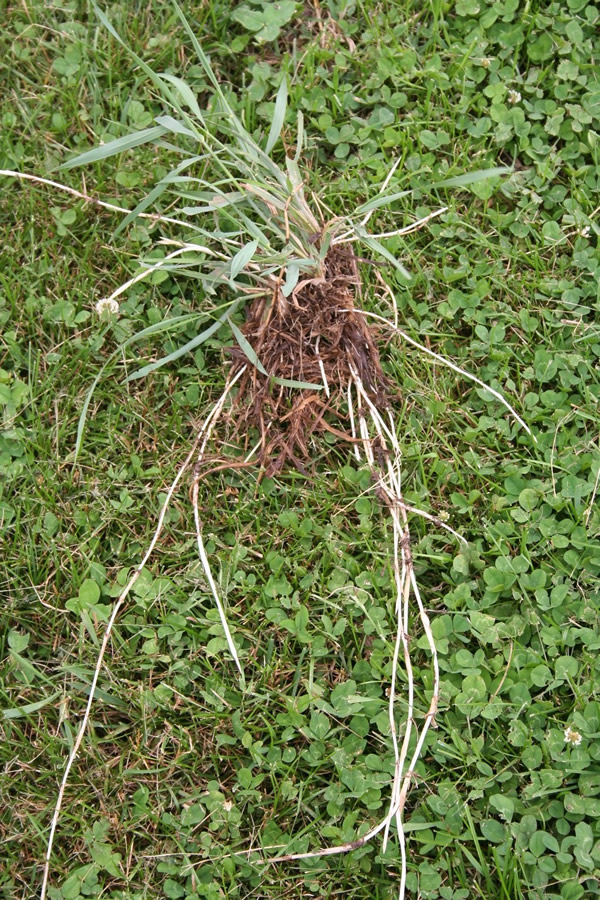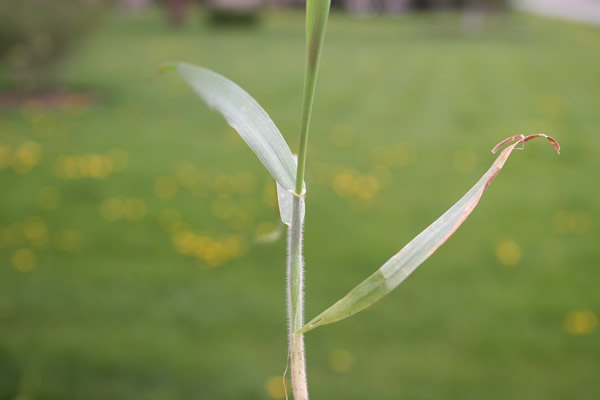Issue 3, May 19, 2021
Quackgrass Identification and Control
Quackgrass (Elytrigia repens) is a coarse textured, cool-season perennial grass that has surely been enjoying the cool temperatures and timely rains we’ve had this growing season. When we see lush new growth of our cool-season turfgrasses, we can often find quackgrass growing happily nearby. It spreads by seeds and long, light-colored rhizomes and aggressively forms patches. Quackgrass can be difficult to eliminate, especially from finer-textured turfgrasses. If you haven’t done so already, scout your landscapes for this weed and plan your control tactics.

Quackgrass’s wide leaves are noticeable in finer textured turf, Michelle Wiesbrook, University of Illinois
Quackgrass can look very different depending on whether it is being kept mowed short or allowed to grow to its full potential. Here are general characteristics to aid in identification. The ligule is membranous and very short. The leaf blades are flat, dull green to light blue green and taper to a pointed tip. Blades grow 1/8 to 1/2 inch wide and can grow 3 to 12 inches long. On the upper surface, the blades are smooth to rough, and may be sparsely hairy. However, on the lower surface, they are smooth. The sheaths can be hairy or smooth. Often, young plants will have hairy sheaths. The leaves have a very short (1/32-inch) membranous ligule. A key identifying feature of quackgrass is the claw-like, slender auricles that clasp the stem. This presence of these structures easily separates this plant from other grassy weeds like crabgrass or various foxtail species.
The rhizomes of quackgrass are long-lived, slender, and white with sharp tips. They can stretch out several feet long producing new roots and shoots every few inches or so. Hand pulling this plant often results in breakage of stems or rhizomes. Unfortunately, remaining stems and rhizomes in the soil will continue to grow. Adding insult to injury, quackgrass can also spread by seed. The seed heads are 2 to 6 inch long spikes that occur from late May to September. Other less common yet appropriate names for this persistent grass include quick grass and devil’s-grass. Additionally, the rhizomes are reportedly edible and I’ve had dogs selectively pull them from my garden waste pile to chew on.

Quackgrass rhizomes, Michelle Wiesbrook, University of Illinois
Quackgrass thrives in well drained soils with slightly acidic pH. It favors thin lawns and other areas where there is little to no competition. It can be a serious management problem in lawns, landscapes, nurseries, and crop areas. To decrease populations of this weed in lawns, maintain turf density and health through proper culture. Low mowing and fertility maintenance may aid in decreasing populations. Turfgrass that grows faster will compete better with this weed. Turfgrass that grows darker will perhaps mask this dark colored weed as well.
Quackgrass is often confused with crabgrass, another common turfgrass weed. However, crabgrass is a lighter green, warm season annual that occurs later and its leaf sheaths remain prominently hairy throughout the growing season. Also, crabgrass spreads by seed only and not by rhizomes as does quackgrass. Finally, remember that crabgrass will not have long, clasping auricles at the base of the leaf.

Young quackgrass can have a hairy sheath, Michelle Wiesbrook, University of Illinois
Identifying grasses can be challenging! For assistance, check out Identifying Turf and Weedy Grasses of the Northern United States. This pocket-sized guide is available for sale at pubsplus.illinois.edu.
Controlling quackgrass can be challenging as well. Apply herbicides in the spring and fall when this plant is actively growing. Once temperatures rise, this weed will go dormant. Unfortunately, there are not any selective herbicides available for use in lawns. Nonselective products such as glyphosate can be used but realize that turfgrass will be injured or killed. In these areas, fall applications would be best as seeding can then follow when temperatures are more conducive for turf seedling growth. In fact sod may be more competitive with any remaining quackgrass rhizomes than turf seedlings would be.
In gardens, cultivation yields poor control due to the rhizomes. Spot or directed applications of glyphosate (RoundUp and others) may be used. Check after a week or so to see if a second application to regrowth is in order. There are herbicides specific for killing grasses that may be tried such as sethoxydim (Hi-Yield Grass Killer and others) or fluazifop (Fusilade II and others). Read and follow all label directions very carefully. If chemical use is not an option, digging by hand may be effective but the entire plant must be removed. Plan to monitor the site and schedule future digging attempts.
Selective products have been available in the past, but have now been removed from the marketplace or the use restrictions on the labels have changed. At one time, turfgrass managers relied on sulfosufuron (Certainty) to control tall fescue growing in other cool-season turves, but cool-season grasses were removed from the label a few years ago. Any existing old stocks can still be used however. I have witnessed several discussions online where turfgrass applicators were suggesting that sulfosulfuron could perhaps still be used with a very loose interpretation of the label. I have cautioned applicators against this for fear that IDA inspectors would not share the loose interpretation. These applications are presumably broadcast in nature. However, it MAY be possible to use sulfosuron as a spot treatment. Applicators should carefully read and follow all label directions!
Some applicators have mentioned that they have seen some control of quackgrass with mesotione (Tenacity) while controlling other grassy weeds such as nimblewill. However, colleagues at Iowa State University report that treated plants turned white but came back stronger than ever. Quackgrass is not listed on the product label.
Author:
Michelle Wiesbrook